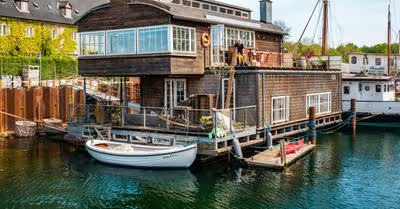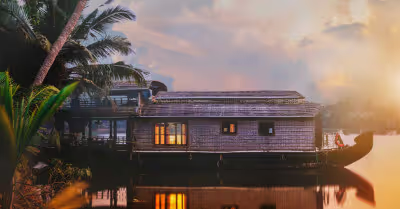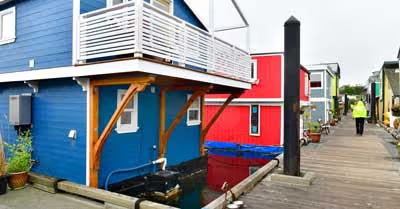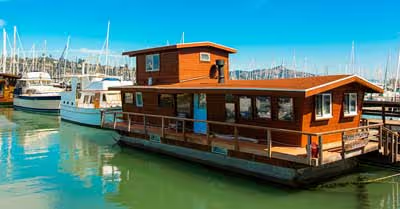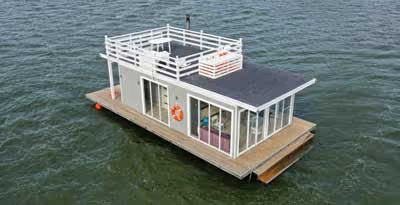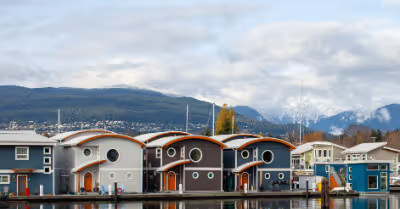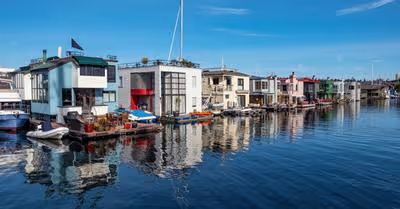
Key Takeaways
- Houseboats are designed primarily for use as residences on the water.
- They can vary in size, design, and features to accommodate different lifestyles.
- Houseboats are commonly found in marinas, along rivers, and on inland lakes.
Ever wondered what a houseboat truly is? Let’s uncover the functionality of these floating residences while offering insights into their distinct lifestyle.
A houseboat is a specially designed boat for dwelling but generally moored in one place. It combines maritime engineering with home amenities, providing a unique living experience on the water. This lifestyle merges the comforts of a traditional home with the adventure of living on the water.
As a seasoned houseboat enthusiast with years of experience, I can assure you that living on water is an adventure like no other. Imagine waking up to gentle waves and ever-changing scenery. It's not just a home, it's a lifestyle that connects you intimately with nature.
What is a Houseboat?
A houseboat is a unique type of watercraft designed primarily for use as a full-time or part-time residence on the water. These floating houses can be found in an array of sizes and styles, offering a range of living options for those seeking an alternative to traditional land-based homes.
Houseboats vary in design and features depending on their intended use and location. Some are simple and modest, while others are more elaborate and can even be two stories tall, offering ample living space and modern amenities.
Design and Features of Houseboats
When considering a houseboat, it's important to understand its design and features. These floating homes offer a unique and comfortable living experience for those who wish to live on the water.
Interior Design
The interior of a houseboat can vary from a simple cabin-like structure to luxurious living spaces with all modern amenities. These homes on the water are designed to provide ample living space, typically featuring bedrooms, kitchens, and bathrooms, just like in a regular home.
The more luxurious houseboats can include air conditioning, rooftop decks, and even hot tubs. Ultimately, the design and features of the houseboat depend on the preferences and budget of the houseboat owner. Check out this video showing some of the best houseboat designs.
Windows and Ventilation
Windows play a crucial role in providing natural light and ventilation to houseboats. They come in various styles and sizes, allowing for a cozy and well-ventilated living space. Some houseboats even have large floor-to-ceiling windows, providing stunning views of the surrounding water and landscape.
Adequate ventilation is essential for maintaining a comfortable and healthy living environment, especially since the close proximity to water can lead to increased humidity levels. To ensure proper air circulation, most houseboats come equipped with vents or other forms of air exchange systems.
The Use of Houseboats
Houseboats provide an alternative to land-based living and offer unique experiences for those who enjoy a connection with the water.
Residential Purpose
Living on a houseboat provides an opportunity to experience a different, more flexible lifestyle. Many houseboats serve as full-time residences. In most cases, these floating homes remain moored in marinas, harbors, or canals.
One of the advantages of living on a houseboat is the ample space it offers, including living quarters, kitchens, and bathrooms. Some houseboats even provide a two-story living space, optimizing their small surface area. Houseboats can also be connected to local utility lines, offering conveniences such as electricity, water, and sewer systems.
Vacationing and Leisure
Not only are houseboats used for full-time living, but they are also excellent for vacationing and leisure. Many people rent houseboats for fishing trips, family vacations, or simply to enjoy the experience of living on the water.
Many houseboats are designed to be mobile, suitable for cruising across picturesque inland lakes and rivers. These cruising houseboats offer unique opportunities for exploring various landscapes while enjoying comfortable living quarters, often equipped with essential amenities.
Not all houseboats are designed for cruising; some, known as non-cruising houseboats, are primarily moored in marinas or docks. The variety of houseboats available includes those built on barges, pontoons, and even narrowboats, offering a range of options to meet the needs and preferences of different owners.
Houseboats can also be found in a variety of locations across the world. These floating-house residences have gained immense popularity in many countries, with cities like San Francisco and towns along European canals featuring houseboat communities.
Houseboats Across the World
Houseboats are a unique combination of housing and boating, offering an alternate form of residency and recreational experience in many parts of the world.
Houseboats in the United States
Houseboats in the United States are gaining immense popularity, particularly in states like Pennsylvania, Mississippi, Georgia, Tennessee, and Florida. Some popular locations for houseboats include Lake Powell and various inland lakes, where ample space and beautiful surroundings make for a serene living experience.
In these areas, both cruising houseboats and non-cruising houseboats can be found, catering to the different preferences of houseboat owners. In some places like San Francisco, floating houses provide unique living quarters in close proximity to land and city life.
- Cruising Houseboats: These types of houseboats are equipped for excursions on water, offering mobility and adventure for their owners.
- Non-Cruising Houseboat: Designed mainly for residential purposes, many of these houseboats remain moored at a fixed location, often connected to local sewer and utility lines.
Houseboats in Germany
In Germany, houseboats have become more popular in recent years. Berlin has seen a rising trend of people opting for floating homes as their primary residence. These floating houses can be found in some of the city’s marinas and canals, offering a unique combination of city life and water-based living.
Most houseboats in Germany are non-cruising, designed primarily for residential purposes, and many are moored at fixed locations with access to land-based facilities and amenities. The popularity of houseboats in Germany owes much to their environmentally friendly nature, as they have a lower impact on land and resources compared to traditional housing.
Houseboats in the United Kingdom
Houseboats have been a part of British culture for decades and even centuries. With an extensive network of rivers and canals, the United Kingdom has plenty of waterways for houseboats to be moored or to sail. The River Thames, for example, is home to numerous houseboat communities.
In the UK, the types of boats used as houseboats vary greatly:
- Narrowboats: Originally used to transport goods through narrow canals, these long, slim vessels offer a unique, cozy living space. They are typically one story and can accommodate up to four people.
- Barges: These larger, flat-bottomed boats offer more living space, often with two stories and a roof deck, suitable for families or individuals who require more room.
- Rafts and Pontoons: A less common option, these floating platforms with living quarters can also be found in the UK, where they provide an inexpensive and simple living alternative.
Types of Houseboats
When it comes to houseboats, there are a variety of options you can choose from depending on your preferences, budget, and lifestyle. You can see different houseboats in this video.
Cabin Cruiser
A Cabin Cruiser is a versatile type of boat that offers both comfort and functionality. These boats are equipped with a cabin, which provides a living space for you and your family. Cabin Cruisers can be an affordable option for those who want to enjoy the boating lifestyle without committing to a full-size houseboat.
Cabin Cruisers are perfect for cruising along rivers, canals, inland lakes, and even coastal waters. They offer ample space for relaxation and come in various sizes, allowing you to choose the one that best suits your needs.
The cabins in these boats usually have a compact yet comfortable design and are equipped with essential amenities, such as a small kitchen, bathroom, and sleeping quarters for up to four people.
Benefits of Cabin Cruisers:
- Convenient size for navigating different waterways
- Affordable option compared to larger houseboats
- Comfortable living quarters for short-term cruising
Floating Cabins
Floating Cabins, also known as floating houses or floating homes, are non-cruising houseboats moored to a dock or marina. These types of houseboats are more stationary and offer a unique alternative to traditional land-based homes.
Floating Cabins provide a more spacious living area, making them ideal for people who prefer to spend more time on the water rather than traveling between locations.
Floating Cabins are typically connected to local sewer and utility lines, providing the same comfort and convenience as a land-based home. They offer significantly more living space compared to Cabin Cruisers, often featuring multiple stories and larger living quarters.
Floating Cabins can be found in marinas along lakes and rivers and even in cities like San Francisco, where they have gained immense popularity.
Benefits of Floating Cabins:
- Larger living space for long-term living on the water
- Connection to local sewer and utility lines
- They are more stable as they are moored to a dock or marina
Here’s a table showing the types of houseboats:



